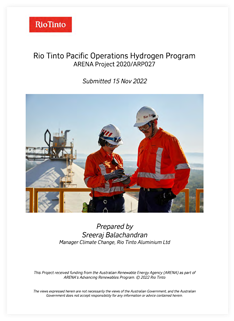This feasibility study report considers the calcination of alumina as an opportunity for decarbonisation by substituting natural gas with hydrogen.
Report extract
 Rio Tinto is committed to net zero greenhouse gas emissions by 2050. As part of this commitment, the calcination of alumina was identified as a significant opportunity, where natural gas may be substituted with green hydrogen, for primary decarbonisation, and the steam produced from the combustion of hydrogen and calcination of alumina may be reused within the refinery, for secondary decarbonisation.
Rio Tinto is committed to net zero greenhouse gas emissions by 2050. As part of this commitment, the calcination of alumina was identified as a significant opportunity, where natural gas may be substituted with green hydrogen, for primary decarbonisation, and the steam produced from the combustion of hydrogen and calcination of alumina may be reused within the refinery, for secondary decarbonisation.
Calcination is the last step in the alumina refining process, requiring temperatures in excess of 900°( to remove chemically bound water that is associated with alumina. This process occurs in alumina calciners that traditionally operate on natural gas and account for approximately 30% of greenhouse gas emissions from alumina refineries. Hydrogen calcination program aims to abate the emissions generated during calcination process by substituting natural gas with hydrogen. Furthermore, capturing and compressing steam from the calciner, can displace the need for fossil fuels for steam generation in the refinery process. The net target of hydrogen calcination and steam capture is up to a net 50% decarbonisation of the overall refinery process.



